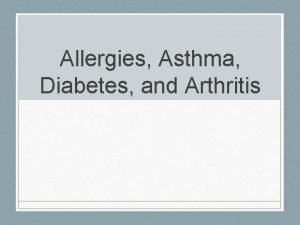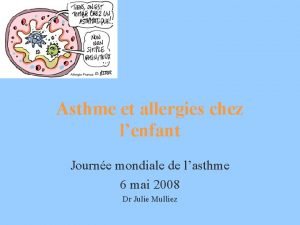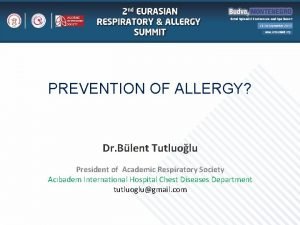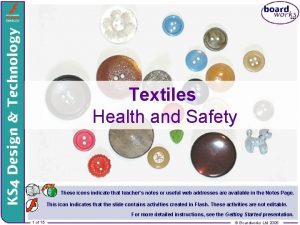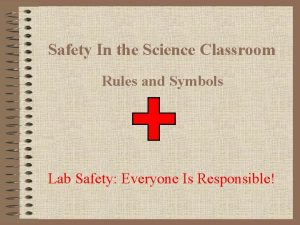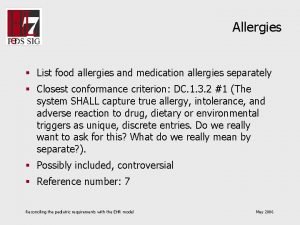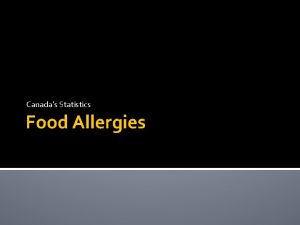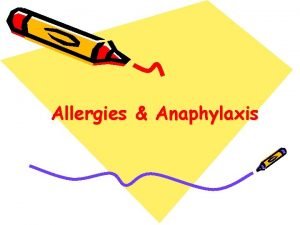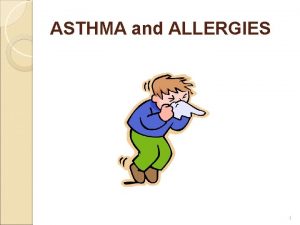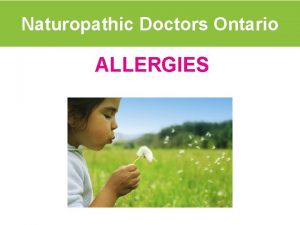FOOD SAFETY FOOD ALLERGIES CLASSROOM FOOD SAFETY q









- Slides: 9

FOOD SAFETY & FOOD ALLERGIES

CLASSROOM FOOD SAFETY q. Wash your hands often. Foodborne illnesses are transmitted by food handlers that contaminate food and food contact surfaces. Individuals who handle food when they have a foodborne illness, gastrointestinal illness, infected lesion, or are around someone who is ill can pass along those illnesses. Individuals can simply touch a surface that is contaminated with a bacteria or virus and pass it along to others. Handwashing minimizes the risk of passing along bacteria or viruses that can cause foodborne illnesses. q Adhere to mealtime schedules. Proper food temperatures must be maintained for service. q Clean and sanitize surfaces before mealtimes. q Use appropriate serving utensils to handle food. q Wear disposable food service gloves when handling ready to eat foods.

HAND WASHING q Hand hygiene is the most important way to reduce the spread of infection. Many studies have shown that improperly cleansed hands are the primary carriers of infections. Deficiencies in hand hygiene have contributed to many outbreaks of diarrhea among children and caregivers/teachers in child care centers. Proper hand washing is the best prevention against food borne illnesses and other diseases. Unwashed or poorly washed hands can transfer harmful bacteria from your hands to those you are feeding. q See Hand Washing Policy

TABLE WASHING & SANITIZING PROCEDURE v Use warm water with enough detergent (Dawn) to create some bubbles and wash off tables using the disposable pink food service wipes. v Fill rinse bucket with clean water and use disposable cloth to rinse tables. v Spray food safe sanitizer on table surface and allow to dry for 2 minutes. If table is still too wet, you can use a clean kitchen paper towel (white towels in classroom) to dry further if needed. v Please do not spray misting products while students are near.

HANDLING READY TO EAT FOODS POLICY Performance Standard: 1302. 47(b)(6)(ii) Rationale: Despite proper hand washing all contamination may not be removed from hands, therefore bare hands contact with ready-to-eat food will be avoided as prescribed by the FDA Food Code (2013) and Maine Food Code (2013). CFOC 4. 9. 0. 3 The following items will be considered ready-to-eat foods and may not be handled with bare hands: Prepared fresh fruits and vegetables served raw Salads and salad ingredients Cooked meats, cold meats and sandwiches Bread, toast, rolls and baked goods Ice Any food that will not be thoroughly cooked or reheated after it is prepared Acceptable alternatives to bare hands would be: § § § § deli paper spatula tongs single-use gloves fork or spoon scoops napkin

FOOD ALLERGIES A food allergy is defined as an adverse health effect arising from a specific immune response that occurs reproducibly on exposure to a given food. The immune response can be severe and life threatening. Symptoms associated with an allergic reaction to food include the following: • Mucous Membrane Symptoms: red watery eyes or swollen lips, tongue, or eyes. • Skin Symptoms: itchiness, flushing, rash, or hives. • Gastrointestinal Symptoms: nausea, pain, cramping, vomiting, diarrhea, or acid reflux. • Upper Respiratory Symptoms: nasal congestion, sneezing, hoarse voice, trouble swallowing, dry staccato cough, or numbness around mouth. • Lower Respiratory Symptoms: deep cough, wheezing, shortness of breath or difficulty breathing, or chest tightness. • Cardiovascular Symptoms: pale or blue skin color, weak pulse, dizziness or fainting, confusion or shock, hypotension (decrease in blood pressure), or loss of consciousness. • Mental or Emotional Symptoms: sense of “impending doom, ” irritability, change in alertness, mood change, or confusion.

FOOD ALLERGY SYMPTOMS IN CHILDREN Children with food allergies might communicate their symptoms in the following ways: • It feels like something is poking my tongue. • My tongue (or mouth) is tingling (or burning). • My tongue (or mouth) itches. • My tongue feels like there is hair on it. • My mouth feels funny. • There’s a frog in my throat; there’s something stuck in my throat. • My tongue feels full (or heavy). • My lips feel tight. • It feels like there are bugs in there (to describe itchy ears). • It (my throat) feels thick. • It feels like a bump is on the back of my tongue (throat). Source: The Food Allergy & Anaphylaxis Network. Food Allergy News. 2003; 13(2).

MANAGING FOOD ALLERGIES Priorities for Managing Food Allergies: q Identify children with food allergies q Reduce the risk of food allergy reactions in individual children q Help students manage their food allergies q Prepare for food allergy emergencies q Educate children and families about food allergies q Create and maintain a healthy and safe educational environment

REQUIRED PAPERWORK - FOOD ALLERGIES Medically based diets or other dietary requirements are accommodated and ensure that a child’s health will not be jeopardized and that individual needs are met. For a child with a disability, any special meal or dietary accommodation must be documented by a Dietary Restriction and Substitution Statement signed by an authorized professional as specified by USDA CACFP. Any dietary modifications that are required for children with disabilities will be made as soon as appropriate documentation has been submitted. For a child without a disability, dietary requests that are not medically necessary will be accommodated if USDA CACFP meal patterns can still be met, the requested item(s) do not exceed more than 10% of usual cost, and the requested item is readily available where supplies are usually purchased. The Nutrition Coordinator must approve all substitutions. Requests for fluid milk substitutes require only a parent signature when the alternate milk selected is approved by USDA CACFP as a product that meets nutrient standards for non-dairy beverages. The written request must identify the special dietary need that restricts the diet of the child. Any special diets, food allergies or intolerances will be clearly posted.
